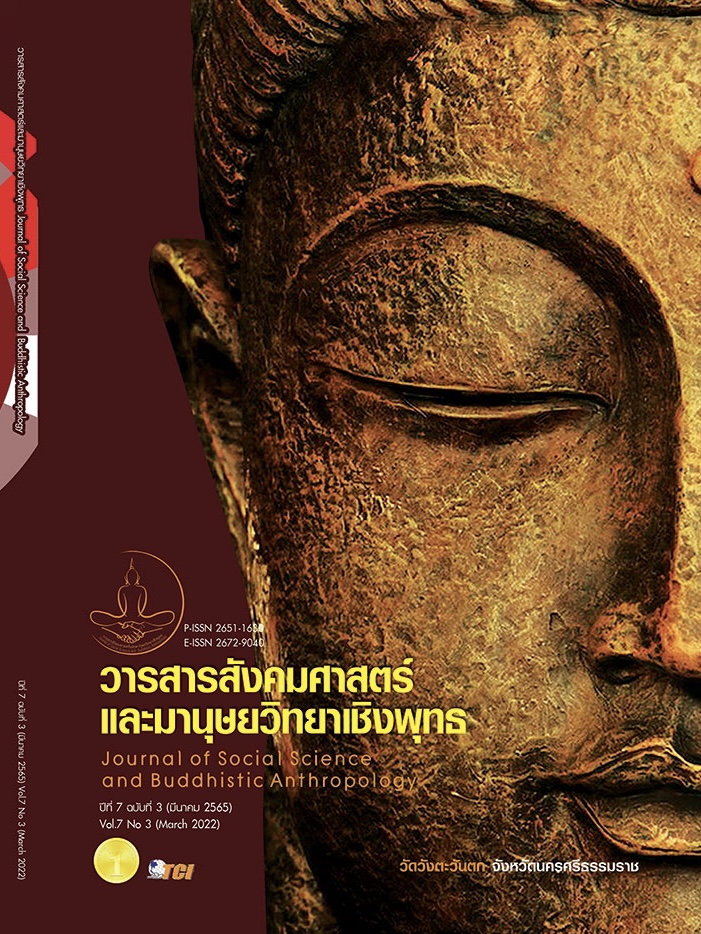THE DIFFUSION OF INNOVATION, PERCEPTION OF RISK, USER's TRUST OF ONLINE BANKING TO THE SUCCESS OF COMMERCIAL BANK IN THAILAND
Keywords:
Diffusion of Innovation, Perceived Risk, User's Trust, Financial Innovation, Online BankingAbstract
The Objectives of this research article were to: 1) study the composition of innovation diffusion factors, reception risk, and user’s trust of online banking, 2) study relation of innovation diffusion, reception risk that affected to user’s trust of online banking, 3) study influence of user’s trust about online banking innovation that affected to the success of commercial banks in Thailand, and 4) to study the success of commercial banks in Thailand, The research was mix method such as quantitative research uses questionnaire as a research tool, sample group that including with 384 people who use online banking services of commercial banks of Thailand, purposive sampling. Data was analyzed using frequency statistics, percentage, mean, standard deviation. And qualitative research uses an in-depth interview form as a research tool. Key informant was: 1) branch manager and 2) branch executive for all 5 persons, purposive sampling. Data was analyzed using content analysis and overview summarizing. The research was found that: 1.composition of factors: 1.1) innovation diffusion ( = 4.42, S.D. = 0.42), 1.2) perceived risk (
= 3.99, S.D. = 0.68), and 1.3) trust (
= 4.12, S.D. = 0.59), 2. The relation was of innovation diffusion found positively correlated with trust, at the middle level, correlation coefficient (r = 0.418) and perceived risk positively correlated with trust at low level so correlation coefficient was (r = 0.514). 3. The influence of trust was warranty, the integrity of the information affects the success of commercial banks. and 4. The success of commercial banks was consists of financial, customer, internal management, and learning and growing.
References
ฐิตยาภรณ์ ธีรานุวรรตน์. (2553). การรับรู้ความเสี่ยง (Perceived Risk) และการรับรู้ถึงความเชื่อมั่นไว้วางใจ (Trust Perception) ของผู้ใช้งานที่ส่งผลต่อความตั้งใจในการใช้บริการ Location-Based Services. ใน สารนิพนธ์ปริญญาวิทยาศาสตร์บัณฑิต สาขาวิชาวิทยาศาสตร์. มหาวิทยาลัยธรรมศาสตร์.
ธนาคารแห่งประเทศไทย. (2559). สรุปเกณฑ์การกํากับดูแลธุรกิจการเงิน ข้อมูล ณ วันที่ 24 เมษายน 2559. เรียกใช้เมื่อ 24 เมษายน 2559 จาก http://www.bot.or.th /Thai/FinancialInstitutions/ PruReg_HB /PruReg_HB/Pages/PruReg_HB. aspx]
บุญชม ศรีสะอาด. (2556). วิธีการทางสถิติสำหรับการวิจัย เล่ม 2. กรุงเทพมหานคร: สุวีริยาการพิมพ์.
ผู้จัดการสาขา 1. (14 มีนาคม 2563). เรื่องอิทธิพลของการแพร่กระจายนวัตกรรม การรับรู้ความเสื่ยง และความไว้วางใจของผู้ใช้บริการนวัตกรรมทางการเงินธนาคารออนไลน์ต่อความสำเร็จของธนาคารพาณิชย์ในประเทศไทย. (เทวินทร์ บุบผาคำ, ผู้สัมภาษณ์)
ผู้จัดการสาขา 2. (14 มีนาคม 2563). เรื่องอิทธิพลของการแพร่กระจายนวัตกรรม การรับรู้ความเสื่ยง และความไว้วางใจของผู้ใช้บริการนวัตกรรมทางการเงินธนาคารออนไลน์ต่อความสำเร็จของธนาคารพาณิชย์ในประเทศไทย. (เทวินทร์ บุบผาคำ, ผู้สัมภาษณ์)
ผู้จัดการสาขา 3. (14 มีนาคม 2563). เรื่องอิทธิพลของการแพร่กระจายนวัตกรรม การรับรู้ความเสื่ยง และความไว้วางใจของผู้ใช้บริการนวัตกรรมทางการเงินธนาคารออนไลน์ต่อความสำเร็จของธนาคารพาณิชย์ในประเทศไทย. (เทวินทร์ บุบผาคำ, ผู้สัมภาษณ์)
ผู้บริหารสาขา 1. (14 มีนาคม 2563). เรื่องอิทธิพลของการแพร่กระจายนวัตกรรม การรับรู้ความเสื่ยง และความไว้วางใจของผู้ใช้บริการนวัตกรรมทางการเงินธนาคารออนไลน์ต่อความสำเร็จของธนาคารพาณิชย์ในประเทศไทย. (เทวินทร์ บุบผาคำ, ผู้สัมภาษณ์)
ผู้บริหารสาขา 2. (14 มีนาคม 2563). เรื่องอิทธิพลของการแพร่กระจายนวัตกรรม การรับรู้ความเสื่ยง และความไว้วางใจของผู้ใช้บริการนวัตกรรมทางการเงินธนาคารออนไลน์ต่อความสำเร็จของธนาคารพาณิชย์ในประเทศไทย. (เทวินทร์ บุบผาคำ, ผู้สัมภาษณ์)
ผู้บริหารสาขา 3. (14 มีนาคม 2563). เรื่องอิทธิพลของการแพร่กระจายนวัตกรรม การรับรู้ความเสื่ยง และความไว้วางใจของผู้ใช้บริการนวัตกรรมทางการเงินธนาคารออนไลน์ต่อความสำเร็จของธนาคารพาณิชย์ในประเทศไทย. (เทวินทร์ บุบผาคำ, ผู้สัมภาษณ์)
ฤทัยภัทร ทําว่อง. (2557). การตัดสินใจเลือกใช้บริการทางการเงินผ่านแอพพลิเคชั่นบนสมาร์ทโฟน ของลูกค้าธนาคารออมสินในเขตลําปาง 1. ใน สารนิพนธ์บริหารธุรกิจมหาบัณฑิต สาขาวิชาบริหารธุรกิ. มหาวิทยาลัยเนชั่น.
สุนทรียา ไชยปัญหา และคณะ. (2559). ความสัมพันธ์เชิงโครงสร้างของการจัดการความรู้ที่มีต่อองค์การแห่งการเรียนรู้ ความคล่องตัวขององค์การและความได้เปรียบในการแข่งขันของธนาคารพาณิชย์ในประเทศไทย. วารสารมนุษยศาสตร์และสังคมศาสตร์, 10(3), 89-104.
อณิยา ฉิมน้อย. (2563). National e-Payment กับการยกระดับศักยภาพของธุรกิจ. เรียกใช้เมื่อ 30 ตุลาคม 2563 จาก https://gmlive.com.
Celent. (2013). Myths, Misconceptions and Enduring Truths. In A Survey of Digitally Direct Consumer 2013. Harper Collins.
Cronbach, L. J. (1990). Essentials of psychological testing. (5th ed.). New York: Harper Collins. Publishers.
Hoyer, W. D. & MacInnis, D. J. (1997). Consumer Behavior. Boston: Houghton Mifflin.
Kim, F. & Raoc, F. (2008). A trust-based consumer decision-making model in electronic commerce: The role of trust, perceived risk, and their antecedents. Decision Support Systems, 44(2), 544–564.
Krejcie, R. V. & Morgan, D. W. (1970). Determining Sample Size for Research Activities. Educational and Psychological Measurement, 30(3), 607-610.
Likert, R. (1967). The Method of Constructing and Attitude Scale. In Reading in Fishbeic, M (Ed.), Attitude Theory and Measurement (pp. 90-95). New York: Wiley & Son.
Montazemi, A. R. & Qahri-Saremi, H. (2015). Factors affecting adoption of online banking: A metaanalytic structural equation modeling study. Information & Management, 52(2), 210–226.
Morgan, R. M. & Hunt, S. D. (1994). The commitment-trust theory of relationship marketing. Journal of Marketing, 58(3), 20-38.
Rogers, E. M. (1995). Diffusion of innovations. (4th ed.). New York: Free Press.
Xue, D. et al. (2011). Determinants and outcomes of internet banking adoption. Management Science, 57(2), 291-307.
Downloads
Published
How to Cite
Issue
Section
License
Copyright (c) 2022 Journal of Social Science and Buddhistic Anthropology

This work is licensed under a Creative Commons Attribution-NonCommercial-NoDerivatives 4.0 International License.








